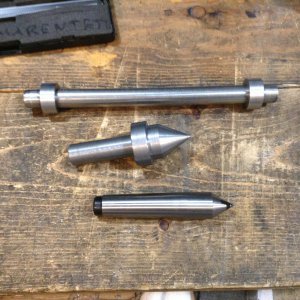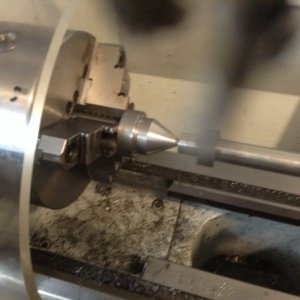This is just my opinion and I know I beat a different drum then most. Why would you even consider to buy something you can easily make and it will be another project under your belt to improve your ability to truly understand the relation.
I think there is too much thought into this when the proof is in the pudding. What you are getting as a result of the cut is what needs to be addressed. To set up an intentional taper To compensate for tooling flex is just a recipe for grief down the road with a tool change or even a different batch of material.
Turn your own 60 degree centre so you don t have to remove your chuck and install the Mt centre. You have to take a 60 degree cut everytime you remove and put it back in your chuck to be concentric.
Make a bar say ten inches long and press on two bushings on each end. Grind your tool with no radius so it is free cutting. Your not worried about surface finish here. Set up an indicator on your tailstock body where it moves with your screw settings. I use no lathe dog just friction turning. Take a cut of a thou. Or three. Move apron over to the other bushing and take the same cut. Measure then compare then move your tailstock over half the difference. Repeat until they measure the same.
In my opinion deflection is something to be dealt with spring cuts, a file and emery cloth and to work within the machines capabilities.
I think there is too much thought into this when the proof is in the pudding. What you are getting as a result of the cut is what needs to be addressed. To set up an intentional taper To compensate for tooling flex is just a recipe for grief down the road with a tool change or even a different batch of material.
Turn your own 60 degree centre so you don t have to remove your chuck and install the Mt centre. You have to take a 60 degree cut everytime you remove and put it back in your chuck to be concentric.
Make a bar say ten inches long and press on two bushings on each end. Grind your tool with no radius so it is free cutting. Your not worried about surface finish here. Set up an indicator on your tailstock body where it moves with your screw settings. I use no lathe dog just friction turning. Take a cut of a thou. Or three. Move apron over to the other bushing and take the same cut. Measure then compare then move your tailstock over half the difference. Repeat until they measure the same.
In my opinion deflection is something to be dealt with spring cuts, a file and emery cloth and to work within the machines capabilities.



